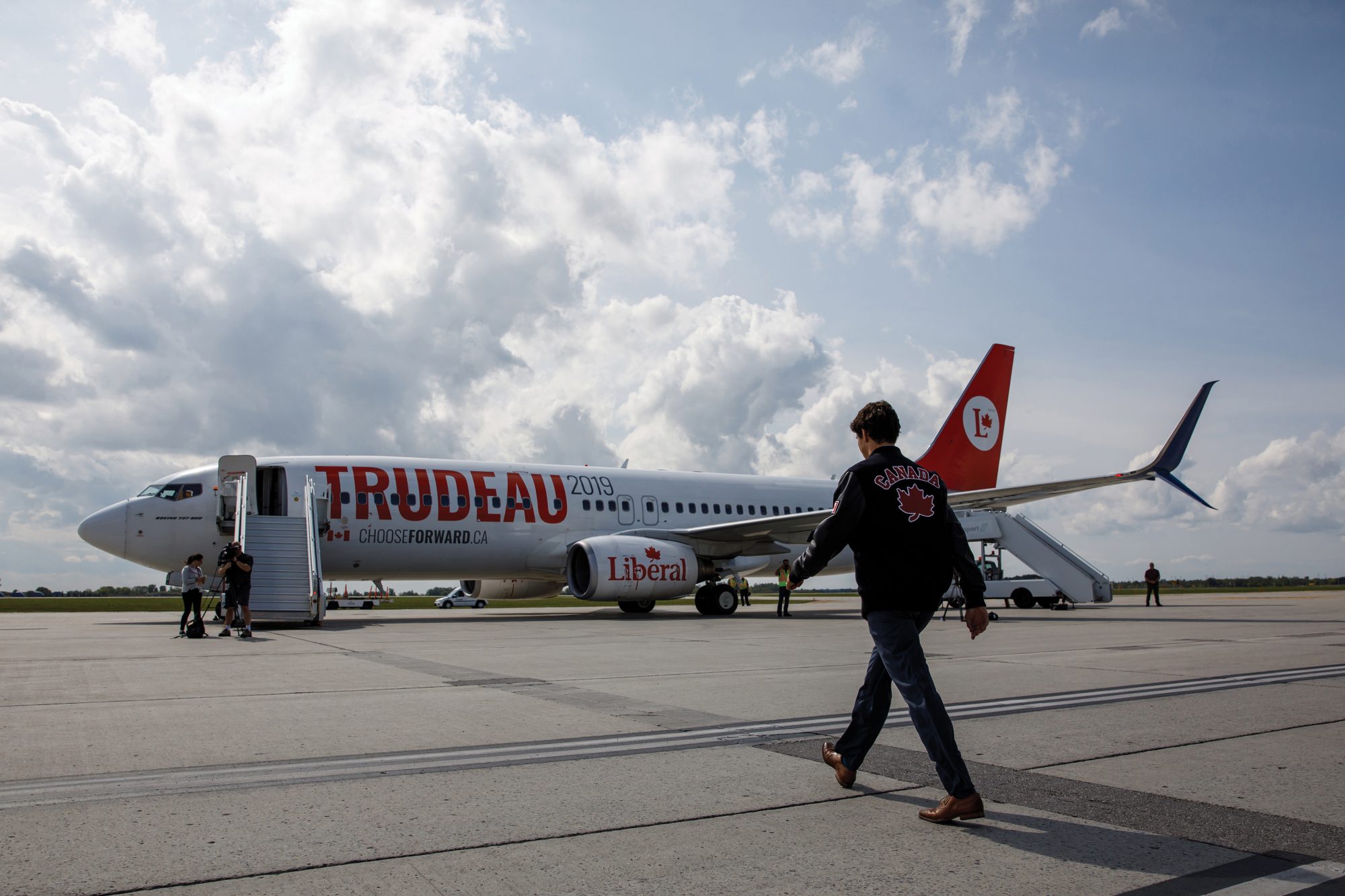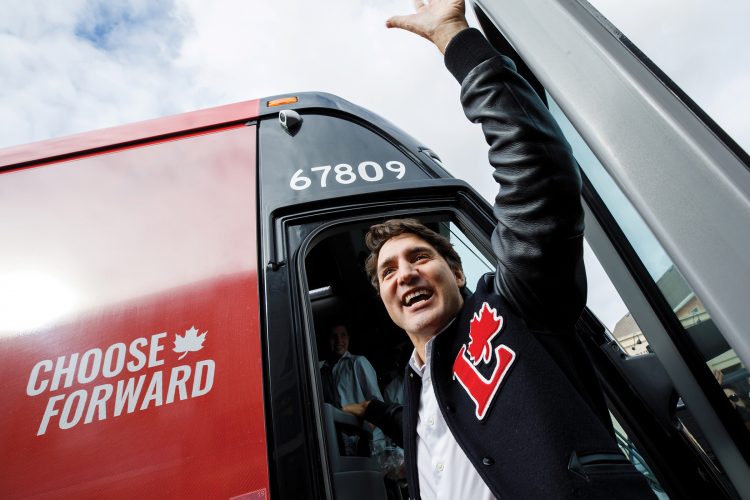The Day the Poetry Died: How the Liberals Snatched Victory from Disaster

Political scandals are not, apparently, what they used to be. Even as the unfathomable images of Justin Trudeau in blackface surfaced six weeks before election day, professionals were hesitating to predict their impact because such calculations have been hacked by the unlikely trajectories of Donald Trump and Boris Johnson. In the end, Trudeau won a minority government, largely, John Delacourt writes, because the party’s foot soldiers rallied.
John Delacourt
On September 18th, barely a week into the 2019 election campaign, the Liberals’ chances for re-election were dealt what most presumed would be a fatal blow: photographs and a video clip of Prime Minister Justin Trudeau in blackface emerged, leaving many, even within the party, feeling that the Trudeau they thought they knew was just a carefully constructed work of fiction. To address the gravity of the situation for those working within the Liberal party headquarters, Jeremy Broadhurst, the national director for the campaign, summoned them all together and delivered what many described as the moment that reaffirmed their faith in the leadership when it had never been more at risk. He acknowledged the sense of disappointment and betrayal many of the people in that room were feeling and did not attempt to dismiss or minimize what this ultimately meant for the days ahead. And he affirmed that what they were working for was far more than getting the leader elected on October 21st; it was about what they had accomplished over four years and what was left to do. As a moment of leadership in crisis, what Broadhurst had to say was effective. The Liberals dug in that much deeper and ultimately pulled off the unlikeliest of election victories.
That’s one version of this first draft of history. There is another, more complex take on the “blackface moment.” Over the first week of the campaign, with the daily cycle of announcements from both parties defining what they hoped to pose as the ballot question, the Conservatives were slowly but effectively gaining ground, despite the polls showing a deadlocked race. Andrew Scheer’s message, as he spoke of taming the deficit and giving tax breaks to those who needed it most, was starting to resonate; the number of Canadians who trusted the Conservatives more than the Liberals as economic managers was one data point that gave the Conservatives reason to be hopeful. This was occurring despite the theme of their campaign being not measurably different from Stephen Harper’s in 2015. It focused on affordability, the uncertainty and anxiety middle class families were feeling about their personal debt and their prospects for retirement and their children’s education. The discovery of Trudeau’s history of appearances in blackface should have only added momentum for Scheer. If past campaigns were any guide, it might have even been considered a game changer. But, as David Coletto of Abacus Research contends, the blackface moment was so disruptive for both campaign narratives that it dramatically changed the conversation among Canadians — to one that, despite the damage that it did to Trudeau’s image, actually helped the Liberals.
To the prime minister’s credit, such a shift would not have been possible without his acceptance of the gravity of the situation. In his first appearance before the media, on the campaign plane a few hours after Time magazine published the first photo, Trudeau’s tone suggested he understood the impact these revelations had for those who had seen in him not just a champion but an ally in the struggle to make the phrase “diversity is our strength” more than just a campaign platitude. And in the course of just a few days the focus shifted from the prime minister’s progressive bona fides to the party’s: specifically, what had been accomplished on the diversity file over the last four years of a Liberal government. If there was any lingering sense of spin or any sudden pivot to the Conservatives’ record on diversity in that first appearance, Trudeau’s chances for re-election would have been lost.
The moment also caused the Liberal war room to change tack. Just days before the writs were issued by the chief electoral officer, the team’s senior leadership intimated that they were more than prepared to “go negative” on Scheer and his slate of candidates. And indeed, over the course of the last few days leading up to the campaign, the Conservatives’ affiliation with anti-abortion activists and Scheer’s stance on same sex marriage, from a speech in 2005, appeared on Facebook and out in the Twitterverse, with posts from Liberal “friendlies” and candidates.
Going negative is, unfortunately, effective, yet it can also lock a campaign into a narrative that leaves it vulnerable to any opponent who can embody a hope and change narrative with greater credibility. There is an implicit virtue signalling in the strategy, an assumption of a moral high ground by pointing out the failings of the other party. It was impossible for the Liberals to deploy the tactic in any great measure from that day forward.

They transitioned from Trudeau’s crisis to an issue only tangentially related to the affordability narrative to define themselves favourably: the environment. As a wedge issue it was an easy read for most Canadians; the Conservatives floated a vague collection of holding lines on the environment in their platform while the NDP and Bloc flatly rejected moving forward with large-scale energy sector projects. For Conservatives, their platform affirmed they were all in for the commemorative vision of Alberta’s boom years. The NDP’s and the Bloc’s environmental planks of their platform effectively signaled to Western Canadians and blue Liberals who might lean progressive on many issues that they weren’t really interested in governing for them. In contrast, Trudeau’s team had the data to support their Goldilocks approach. Internal polling from as far back as 2015 had confirmed for them that most Canadians were ahead of governments in their understanding of the seriousness of the climate change crisis and the need for the federal government to do something about it. It may have been hard for the Liberals to trumpet their record as successful, given the challenges they’ve faced with the provinces in the implementation of a carbon tax, and with the COP21 emissions targets. Still, they could claim they were staying the course, and that they were pragmatists and realists in their approach.
Yet while realism and adroit recovery from crises may be necessary attributes for a governing party, they can hardly create momentum during an election. “Campaign in poetry, govern in prose” might be the well-worn Mario Cuomo dictum from elections past, but what if all you have left is the prosaic? For many Liberal caucus members hoping to be re-elected, it meant you toughed it out on the ground, identifying the vote, bringing out the faithful to the advance polls, knocking on more doors per day than ever before. As it was for Kathleen Wynne in Ontario in 2014 (and, not coincidentally, many Wynne Liberals were working on this campaign for Trudeau), the focus on the fundamentals — good data and multiple touch points for micro-targeting likely voters — was the ultimate factor in securing their victories.
It creates no small change in caucus dynamics for Trudeau. The PMO could convincingly make the case for micromanaging caucus back in 2015 by telling themselves it was the leader’s charisma that got the team elected. Now, this reduced and campaign-toughened number of backbenchers on the governing side of the House can credibly state they have earned their place by their own efforts – despite the national campaign team, the war room and the Leader.
The definition of a Pyrrhic victory is one that is managed at too great a cost for the victors. That’s not quite the case for Trudeau, but this election’s result does present a considerable challenge for the next campaign that might come all too soon: with sunny ways but a memory, how does he build the trust and the political capital to win a third mandate?
John Delacourt, Vice President and Group Leader for Hill and Knowlton’s public affairs practice in Ottawa, is a former director of communications for the Liberal Research Bureau and the author of three books.
